 Para Descargar PDF debe Abrir sesión.
Para Descargar PDF debe Abrir sesión.
Among the therapeutic alternatives available for the treatment of lower pole renal calculi are extracorporeal lithotripsy, percutaneous nephrolithotomy and retrograde intrarenal surgery. There is controversy about which of these techniques is more effective, especially for stones smaller than 20 mm. Searching in Epistemonikos database, which is maintained by screening 30 databases, we identified four systematic reviews including 11 pertinent randomized controlled trials overall. We combined the evidence and generated a summary of findings following the GRADE approach. We concluded percutaneous nephrolithotomy probably increases success rate, but it is not clear if it decreases the need of retreatment compared to extracorporeal shock wave lithotripsy. In comparison to retrograde intrarenal surgery, it may increase success rate, but it is not clear if it decreases the need of retreatment. Retrograde intrarenal surgery may increase success rate, and probably decreases need of retreatment compared to extracorporeal shock wave lithotripsy.
Nephrolithiasis is a common urological disease in clinical practice. The probability of spontaneously eliminating stones mainly depends on their size and location. Renal lower pole stones have a very low probability of being eliminated so they occasionally require active treatment. Common therapeutic alternatives are extracorporeal lithotripsy, percutaneous nephrolithotomy and retrograde intrarenal surgery. There is controversy about which of these techniques is more effective, especially for stones smaller than 20 millimeters.
We used Epistemonikos database, which is maintained by screening more than 30 databases, to identify systematic reviews and their included primary studies. With this information we generated a structured summary using a pre-established format, which includes key messages, a summary of the body of evidence (presented as an evidence matrix in Epistemonikos), meta-analysis of the total of studies, a summary of findings table following the GRADE approach and a table of other considerations for decision-making.
|
Key messages
|
|
What is the evidence. |
We found four systematic reviews [1],[2],[3],[4], that identified 19 pertinent primary studies reported in 25 references [5],[6],[7],[8],[9],[10],[11],[12],[13],[14], |
|
What types of patients were included |
All studies included patients with renal lower pole nephrolithiasis were included. The studies had a similar proportion of men and women, and they had a wide distribution in terms of age. All studies included patients over 18 years. Pretreatment average diameter of stones ranged between 4 mm and 30 mm. |
|
What types of interventions were included |
Four studies compared percutaneous nephrolithotomy to lithotripsy [6],[8],[23],[27],[28], five compared extracorporeal lithotripsy to retrograde intrarenal surgery |
|
What types of outcomes |
Success of the intervention (defined as being stone free at different periods of follow-up), retreatment rate. Other outcomes were operative time, hospital stay, complication rate (defined as hematuria, fever, sepsis, ileus, etcetera) and quality of life. Length of follow-up ranged from 1 month to 16 months in the different studies. |
The information on the comparative effects of the different interventions for lower pole renal calculi is based on 11 studies including 885 patients.
1.- Percutaneous Nephrolithotomy versus shock wave lithotripsy
Four randomised controlled trials reported this comparison [6],[8],[23],[27],[28], including 340 patients overall. All studies reported success rate (stone free) at three months and only two studies reported need of retreatment.
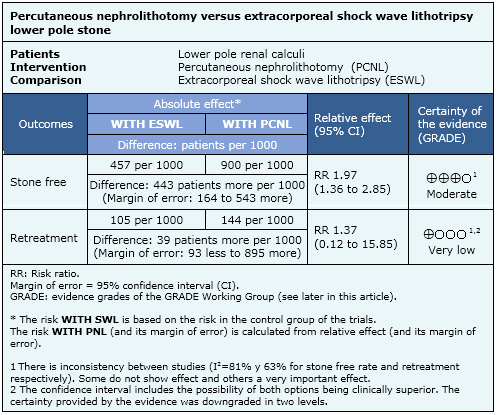
2.- Retrograde intrarenal surgery versus percutaneous nephrolithotomy
Only one randomized trial evaluated this comparison [18], including 33 patients. Stone free rate and retreatment rate were reported at 3 months.
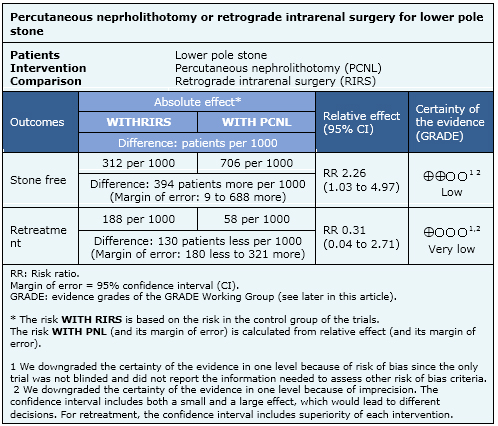
3.- Retrograde intrarenal surgery versus shock wave lithotripsy
Five randomized controlled trials evaluated this comparison [15],[16],[17],[21],[22],[24],[25],[26], including 508 patients overall. All studies reported stone-free rate and retreatment need at three months.
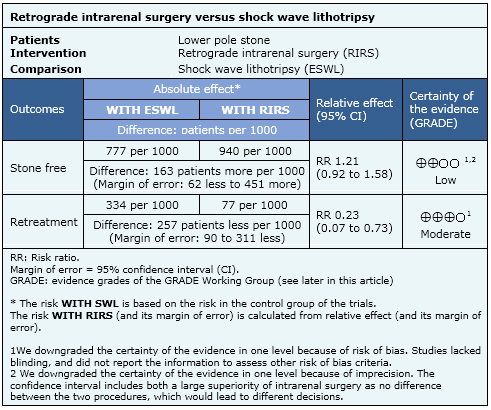
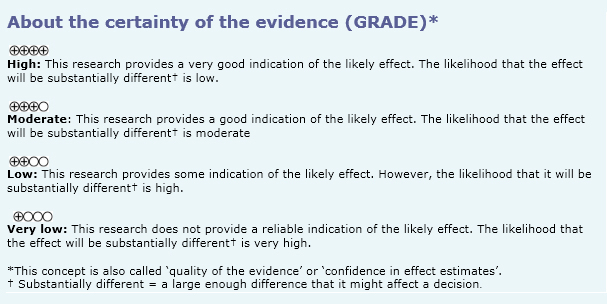
|
To whom this evidence does and does not apply |
|
| About the outcomes included in this summary |
|
| Balance between benefits and risks, and certainty of the evidence |
|
| Resource considerations |
|
|
Differences between this summary and other sources |
|
| Could this evidence change in the future? |
|
Using automated and collaborative means, we compiled all the relevant evidence for the question of interest and we present it as a matrix of evidence.
Matrix of evidence (static version).
Follow the link to access the interactive version: Extracorporeal shock wave lithotripsy, percutaneous nephrolithotomy or retrograde intrarenal surgery for lower pole renal stones
The upper portion of the matrix of evidence will display a warning of “new evidence” if new systematic reviews are published after the publication of this summary. Even though the project considers the periodical update of these summaries, users are invited to comment in Medwave or to contact the authors through email if they find new evidence and the summary should be updated earlier. After creating an account in Epistemonikos, users will be able to save the matrixes and to receive automated notifications any time new evidence potentially relevant for the question appears.
The details about the methods used to produce these summaries are described here http://dx.doi.org/10.5867/medwave.2014.06.5997.
Epistemonikos foundation is a non-for-profit organization aiming to bring information closer to health decision-makers with technology. Its main development is Epistemonikos database (www.epistemonikos.org).
These summaries follow a rigorous process of internal peer review.
Conflicts of interest
The authors do not have relevant interests to declare.

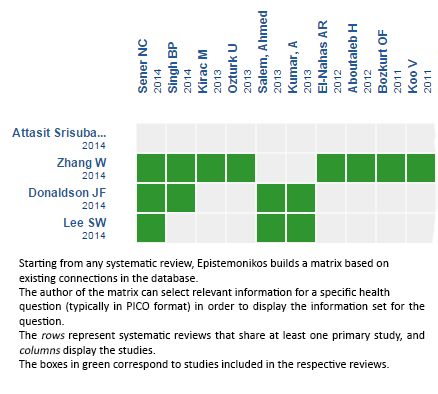 Matrix of evidence (static version).
Matrix of evidence (static version).
 Esta obra de Medwave está bajo una licencia Creative Commons Atribución-NoComercial 3.0 Unported. Esta licencia permite el uso, distribución y reproducción del artículo en cualquier medio, siempre y cuando se otorgue el crédito correspondiente al autor del artículo y al medio en que se publica, en este caso, Medwave.
Esta obra de Medwave está bajo una licencia Creative Commons Atribución-NoComercial 3.0 Unported. Esta licencia permite el uso, distribución y reproducción del artículo en cualquier medio, siempre y cuando se otorgue el crédito correspondiente al autor del artículo y al medio en que se publica, en este caso, Medwave.

Among the therapeutic alternatives available for the treatment of lower pole renal calculi are extracorporeal lithotripsy, percutaneous nephrolithotomy and retrograde intrarenal surgery. There is controversy about which of these techniques is more effective, especially for stones smaller than 20 mm. Searching in Epistemonikos database, which is maintained by screening 30 databases, we identified four systematic reviews including 11 pertinent randomized controlled trials overall. We combined the evidence and generated a summary of findings following the GRADE approach. We concluded percutaneous nephrolithotomy probably increases success rate, but it is not clear if it decreases the need of retreatment compared to extracorporeal shock wave lithotripsy. In comparison to retrograde intrarenal surgery, it may increase success rate, but it is not clear if it decreases the need of retreatment. Retrograde intrarenal surgery may increase success rate, and probably decreases need of retreatment compared to extracorporeal shock wave lithotripsy.
 Autores:
Alejandro Rojas[1,3], Héctor Gallegos[1,3], José A. Salvadó[2,3]
Autores:
Alejandro Rojas[1,3], Héctor Gallegos[1,3], José A. Salvadó[2,3]

Citación: Rojas A, Gallegos H, Salvadó JA. Shock wave lithotripsy, retrograde intrarenal surgery or percutaneous nephrolithotomy for lower pole renal stones?. Medwave 2015;15(Suppl 2):e6254 doi: 10.5867/medwave.2015.6254
Fecha de publicación: 9/9/2015

Nos complace que usted tenga interés en comentar uno de nuestros artículos. Su comentario será publicado inmediatamente. No obstante, Medwave se reserva el derecho a eliminarlo posteriormente si la dirección editorial considera que su comentario es: ofensivo en algún sentido, irrelevante, trivial, contiene errores de lenguaje, contiene arengas políticas, obedece a fines comerciales, contiene datos de alguna persona en particular, o sugiere cambios en el manejo de pacientes que no hayan sido publicados previamente en alguna revista con revisión por pares.
Aún no hay comentarios en este artículo.
Para comentar debe iniciar sesión
 Medwave publica las vistas HTML y descargas PDF por artículo, junto con otras métricas de redes sociales.
Medwave publica las vistas HTML y descargas PDF por artículo, junto con otras métricas de redes sociales.
 Srisubat A, Potisat S, Lojanapiwat B, Setthawong V, Laopaiboon M.Extracorporeal shock wave lithotripsy (ESWL) versus percutaneous nephrolithotomy (PCNL) or retrograde intrarenal surgery (RIRS) for kidney stones. Cochrane Database Syst Rev. 2014 Nov 24;11:CD007044. | CrossRef | PubMed |
Srisubat A, Potisat S, Lojanapiwat B, Setthawong V, Laopaiboon M.Extracorporeal shock wave lithotripsy (ESWL) versus percutaneous nephrolithotomy (PCNL) or retrograde intrarenal surgery (RIRS) for kidney stones. Cochrane Database Syst Rev. 2014 Nov 24;11:CD007044. | CrossRef | PubMed | Donaldson JF, Lardas M, Scrimgeour D, Stewart F, MacLennan S, Lam TB, et al. Systematic review and meta-analysis of the clinical effectiveness of shock wave lithotripsy, retrograde intrarenal surgery, and percutaneous nephrolithotomy for lower-pole renal stones. Eur Urol. 2015 Apr;67(4):612-6. | CrossRef | PubMed |
Donaldson JF, Lardas M, Scrimgeour D, Stewart F, MacLennan S, Lam TB, et al. Systematic review and meta-analysis of the clinical effectiveness of shock wave lithotripsy, retrograde intrarenal surgery, and percutaneous nephrolithotomy for lower-pole renal stones. Eur Urol. 2015 Apr;67(4):612-6. | CrossRef | PubMed | Lee SW, Chaiyakunapruk N, Chong HY, Liong ML. Comparative effectiveness and safety of various treatment procedures for lower pole renal calculi: a systematic review and network meta-analysis. BJU Int. 2015 Aug;116(2):252-64. | CrossRef | PubMed |
Lee SW, Chaiyakunapruk N, Chong HY, Liong ML. Comparative effectiveness and safety of various treatment procedures for lower pole renal calculi: a systematic review and network meta-analysis. BJU Int. 2015 Aug;116(2):252-64. | CrossRef | PubMed | Zhang W, Zhou T, Wu T, Gao X, Peng Y, Xu C, et al. Retrograde Intrarenal Surgery Versus Percutaneous Nephrolithotomy Versus Extracorporeal Shockwave Lithotripsy for Treatment of Lower Pole Renal Stones: A Meta-Analysis and Systematic Review. J Endourol. 2015 Jul;29(7):745-59. | CrossRef | PubMed |
Zhang W, Zhou T, Wu T, Gao X, Peng Y, Xu C, et al. Retrograde Intrarenal Surgery Versus Percutaneous Nephrolithotomy Versus Extracorporeal Shockwave Lithotripsy for Treatment of Lower Pole Renal Stones: A Meta-Analysis and Systematic Review. J Endourol. 2015 Jul;29(7):745-59. | CrossRef | PubMed | Aboutaleb H, El-Shazly M, Badr Eldin M. Lower pole midsize (1-2 cm) calyceal stones: outcome analysis of 56 cases. Urol Int. 2012;89(3):348-54. | CrossRef | PubMed |
Aboutaleb H, El-Shazly M, Badr Eldin M. Lower pole midsize (1-2 cm) calyceal stones: outcome analysis of 56 cases. Urol Int. 2012;89(3):348-54. | CrossRef | PubMed | Albala DM, Assimos DG, Clayman RV, Denstedt JD, Grasso M, Gutierrez-Aceves J, et al. Lower pole I: a prospective randomized trial of extracorporeal shock wave lithotripsy and percutaneous nephrostolithotomy for lower pole nephrolithiasis-initial results. J Urol. 2001 Dec;166(6):2072-80. Erratum in: J Urol 2002 Apr;167(4):1805. | PubMed |
Albala DM, Assimos DG, Clayman RV, Denstedt JD, Grasso M, Gutierrez-Aceves J, et al. Lower pole I: a prospective randomized trial of extracorporeal shock wave lithotripsy and percutaneous nephrostolithotomy for lower pole nephrolithiasis-initial results. J Urol. 2001 Dec;166(6):2072-80. Erratum in: J Urol 2002 Apr;167(4):1805. | PubMed | Bozkurt OF, Resorlu B, Yildiz Y, Can CE, Unsal A. Retrograde intrarenal surgery versus percutaneous nephrolithotomy in the management of lower-pole renal stones with a diameter of 15 to 20 mm. J Endourol. 2011 Jul;25(7):1131-5. | CrossRef | PubMed |
Bozkurt OF, Resorlu B, Yildiz Y, Can CE, Unsal A. Retrograde intrarenal surgery versus percutaneous nephrolithotomy in the management of lower-pole renal stones with a diameter of 15 to 20 mm. J Endourol. 2011 Jul;25(7):1131-5. | CrossRef | PubMed | Carlsson P, Kinn AC, Tiselius HG, Ohlsén H, Rahmqvist M. Cost effectiveness of extracorporeal shock wave lithotripsy and percutaneous nephrolithotomy for medium-sized kidney stones. A randomised clinical trial. Scand J Urol Nephrol. 1992;26(3):257-63.
| PubMed |
Carlsson P, Kinn AC, Tiselius HG, Ohlsén H, Rahmqvist M. Cost effectiveness of extracorporeal shock wave lithotripsy and percutaneous nephrolithotomy for medium-sized kidney stones. A randomised clinical trial. Scand J Urol Nephrol. 1992;26(3):257-63.
| PubMed | Deem S, Davalos J, DeFade B, Martinez F. Percutaneous nephrolithotomy versus extracorporeal shockwave lithotripsy for moderate sized kidney stones. J of Urology. 2010;183(4):e702-e3. | CrossRef |
Deem S, Davalos J, DeFade B, Martinez F. Percutaneous nephrolithotomy versus extracorporeal shockwave lithotripsy for moderate sized kidney stones. J of Urology. 2010;183(4):e702-e3. | CrossRef | Deem S, Defade B, Modak A, Emmett M, Martinez F, Davalos J. Percutaneous nephrolithotomy versus extracorporeal shock wave lithotripsy for moderate sized kidney stones. Urology. 2011 Oct;78(4):739-43. | CrossRef | PubMed |
Deem S, Defade B, Modak A, Emmett M, Martinez F, Davalos J. Percutaneous nephrolithotomy versus extracorporeal shock wave lithotripsy for moderate sized kidney stones. Urology. 2011 Oct;78(4):739-43. | CrossRef | PubMed | El-Nahas AR, Ibrahim HM, Youssef RF, Sheir KZ. Flexible ureterorenoscopy versus extracorporeal shock wave lithotripsy for treatment of lower pole stones of 10-20 mm. BJU Int. 2012 Sep;110(6):898-902. | CrossRef | PubMed |
El-Nahas AR, Ibrahim HM, Youssef RF, Sheir KZ. Flexible ureterorenoscopy versus extracorporeal shock wave lithotripsy for treatment of lower pole stones of 10-20 mm. BJU Int. 2012 Sep;110(6):898-902. | CrossRef | PubMed | Havel D, Saussine C, Fath C, Lang H, Faure F, Jacqmin D. Single stones of the lower pole of the kidney. Comparative results of extracorporeal shock wave lithotripsy and percutaneous nephrolithotomy. Eur Urol. 1998;33(4):396-400. | PubMed |
Havel D, Saussine C, Fath C, Lang H, Faure F, Jacqmin D. Single stones of the lower pole of the kidney. Comparative results of extracorporeal shock wave lithotripsy and percutaneous nephrolithotomy. Eur Urol. 1998;33(4):396-400. | PubMed | Kirac M, Bozkurt ÖF, Tunc L, Guneri C, Unsal A, Biri H. Comparison of retrograde intrarenal surgery and mini-percutaneous nephrolithotomy in management of lower-pole renal stones with a diameter of smaller than 15 mm. Urolithiasis. 2013 Jun;41(3):241-6. | CrossRef | PubMed |
Kirac M, Bozkurt ÖF, Tunc L, Guneri C, Unsal A, Biri H. Comparison of retrograde intrarenal surgery and mini-percutaneous nephrolithotomy in management of lower-pole renal stones with a diameter of smaller than 15 mm. Urolithiasis. 2013 Jun;41(3):241-6. | CrossRef | PubMed | Koo V, Young M, Thompson T, Duggan B. Cost-effectiveness and efficiency of shockwave lithotripsy vs flexible ureteroscopic holmium:yttrium-aluminium-garnet laser lithotripsy in the treatment of lower pole renal calculi. BJU Int. 2011 Dec;108(11):1913-6. | CrossRef | PubMed |
Koo V, Young M, Thompson T, Duggan B. Cost-effectiveness and efficiency of shockwave lithotripsy vs flexible ureteroscopic holmium:yttrium-aluminium-garnet laser lithotripsy in the treatment of lower pole renal calculi. BJU Int. 2011 Dec;108(11):1913-6. | CrossRef | PubMed | Kumar A, Vasudeva P, Nanda B, Kumar N, Das MK, Jha SK. A Prospective randomized comparison between shock wave lithotripsy and flexible reterorenoscopy for lower caliceal stones ≤2 cm: a single-center experience. J Endourol. 2015 May;29(5):575-9. | CrossRef | PubMed |
Kumar A, Vasudeva P, Nanda B, Kumar N, Das MK, Jha SK. A Prospective randomized comparison between shock wave lithotripsy and flexible reterorenoscopy for lower caliceal stones ≤2 cm: a single-center experience. J Endourol. 2015 May;29(5):575-9. | CrossRef | PubMed | Kuo RL, Lingeman JE, Leveillee RJ. Lower pole II: Initial results from a comparison of extracorporeal shock wave lithotripsy, ureteroscopy and percutaneous nephrostolithotomy for lower pole nephrolithiasis. J of Endourology. 2002;16(Suppl):A60.
Kuo RL, Lingeman JE, Leveillee RJ. Lower pole II: Initial results from a comparison of extracorporeal shock wave lithotripsy, ureteroscopy and percutaneous nephrostolithotomy for lower pole nephrolithiasis. J of Endourology. 2002;16(Suppl):A60.  Kuo RL, Lingeman JE, Leveillee RJ. Lower pole II: initial results from a comparison of shock wave lithotripsy (SWL), ureteroscopy (URS), and percutaneous nephrostolithotomy (PNL) for lower pole nephrolithiasis. J of Urology. 2003;169(Suppl):486.
Kuo RL, Lingeman JE, Leveillee RJ. Lower pole II: initial results from a comparison of shock wave lithotripsy (SWL), ureteroscopy (URS), and percutaneous nephrostolithotomy (PNL) for lower pole nephrolithiasis. J of Urology. 2003;169(Suppl):486.  Kuo RL, Lingeman JE, Leveillee RJ, Pearle MS, Watkins S. A randomized clinical trial of ureteroscopy and percutaneous nephrolithotomy for lower pole stones between 11 and 25 mm. Journal of Endourology. 2003;17:A31.
Kuo RL, Lingeman JE, Leveillee RJ, Pearle MS, Watkins S. A randomized clinical trial of ureteroscopy and percutaneous nephrolithotomy for lower pole stones between 11 and 25 mm. Journal of Endourology. 2003;17:A31.  Netto NR Jr, Claro JF, Lemos GC, Cortado PL. Renal calculi in lower pole calices: what is the best method of treatment? J Urol. 1991 Sep;146(3):721-3. | PubMed |
Netto NR Jr, Claro JF, Lemos GC, Cortado PL. Renal calculi in lower pole calices: what is the best method of treatment? J Urol. 1991 Sep;146(3):721-3. | PubMed | Ozturk U, Sener NC, Goktug HN, Nalbant I, Gucuk A, Imamoglu MA. Comparison of percutaneous nephrolithotomy, shock wave lithotripsy, and retrograde intrarenal surgery for lower pole renal calculi 10-20 mm. Urol Int. 2013;91(3):345-9. | CrossRef | PubMed |
Ozturk U, Sener NC, Goktug HN, Nalbant I, Gucuk A, Imamoglu MA. Comparison of percutaneous nephrolithotomy, shock wave lithotripsy, and retrograde intrarenal surgery for lower pole renal calculi 10-20 mm. Urol Int. 2013;91(3):345-9. | CrossRef | PubMed | Pearle MS, Lingeman JE, Leveillee R, Kuo R, Preminger GM, Nadler RB, et al. Prospective, randomized trial comparing shock wave lithotripsy and ureteroscopy for lower pole caliceal calculi 1 cm or less. J Urol. 2005 Jun;173(6):2005-9. | PubMed |
Pearle MS, Lingeman JE, Leveillee R, Kuo R, Preminger GM, Nadler RB, et al. Prospective, randomized trial comparing shock wave lithotripsy and ureteroscopy for lower pole caliceal calculi 1 cm or less. J Urol. 2005 Jun;173(6):2005-9. | PubMed | Pearle MS, Lingeman JE, Leveillee R, Kuo R, Preminger GM, Nadler RB, et al. Prospective randomized trial comparing shock wave lithotripsy and ureteroscopy for lower pole caliceal calculi 1 cm or less. J Urol. 2008 May;179(5 Suppl):S69-73. | CrossRef | PubMed |
Pearle MS, Lingeman JE, Leveillee R, Kuo R, Preminger GM, Nadler RB, et al. Prospective randomized trial comparing shock wave lithotripsy and ureteroscopy for lower pole caliceal calculi 1 cm or less. J Urol. 2008 May;179(5 Suppl):S69-73. | CrossRef | PubMed | Preminger GM. Management of lower pole renal calculi: shock wave lithotripsy versus percutaneous nephrolithotomy versus flexible ureteroscopy. Urol Res. 2006 Apr;34(2):108-11. Epub 2006 Feb 7. | PubMed |
Preminger GM. Management of lower pole renal calculi: shock wave lithotripsy versus percutaneous nephrolithotomy versus flexible ureteroscopy. Urol Res. 2006 Apr;34(2):108-11. Epub 2006 Feb 7. | PubMed | Salem A, Saad I, Emran A, Abdelhakiem M, Abdelrazzak O, Abdelkader M. Laser lithotripsy versus eswl for lower calyceal renal stones. Journal of Urology. 2013;189(4, Supplement):e751 (1829). | CrossRef |
Salem A, Saad I, Emran A, Abdelhakiem M, Abdelrazzak O, Abdelkader M. Laser lithotripsy versus eswl for lower calyceal renal stones. Journal of Urology. 2013;189(4, Supplement):e751 (1829). | CrossRef | Sener NC, Imamoglu MA, Bas O, Ozturk U, Goktug HN, Tuygun C, Bakirtas H. Prospective randomized trial comparing shock wave lithotripsy and flexible ureterorenoscopy for lower pole stones smaller than 1 cm. Urolithiasis. 2014 Apr;42(2):127-31. | CrossRef | PubMed |
Sener NC, Imamoglu MA, Bas O, Ozturk U, Goktug HN, Tuygun C, Bakirtas H. Prospective randomized trial comparing shock wave lithotripsy and flexible ureterorenoscopy for lower pole stones smaller than 1 cm. Urolithiasis. 2014 Apr;42(2):127-31. | CrossRef | PubMed | Singh BP, Prakash J, Sankhwar SN, Dhakad U, Sankhwar PL, Goel A, et al.Retrograde intrarenal surgery vs extracorporeal shock wave lithotripsy for intermediate size inferior pole calculi: a prospective assessment of objective and subjective outcomes. Urology. 2014 May;83(5):1016-22. | CrossRef | PubMed |
Singh BP, Prakash J, Sankhwar SN, Dhakad U, Sankhwar PL, Goel A, et al.Retrograde intrarenal surgery vs extracorporeal shock wave lithotripsy for intermediate size inferior pole calculi: a prospective assessment of objective and subjective outcomes. Urology. 2014 May;83(5):1016-22. | CrossRef | PubMed | Yuruk E, Binbay M, Sari E, Akman T, Altinyay E, Baykal M, et al. A prospective, randomized trial of management for asymptomatic lower pole calculi. The Journal of urology. 2010;183(4):1424-8.
Yuruk E, Binbay M, Sari E, Akman T, Altinyay E, Baykal M, et al. A prospective, randomized trial of management for asymptomatic lower pole calculi. The Journal of urology. 2010;183(4):1424-8.